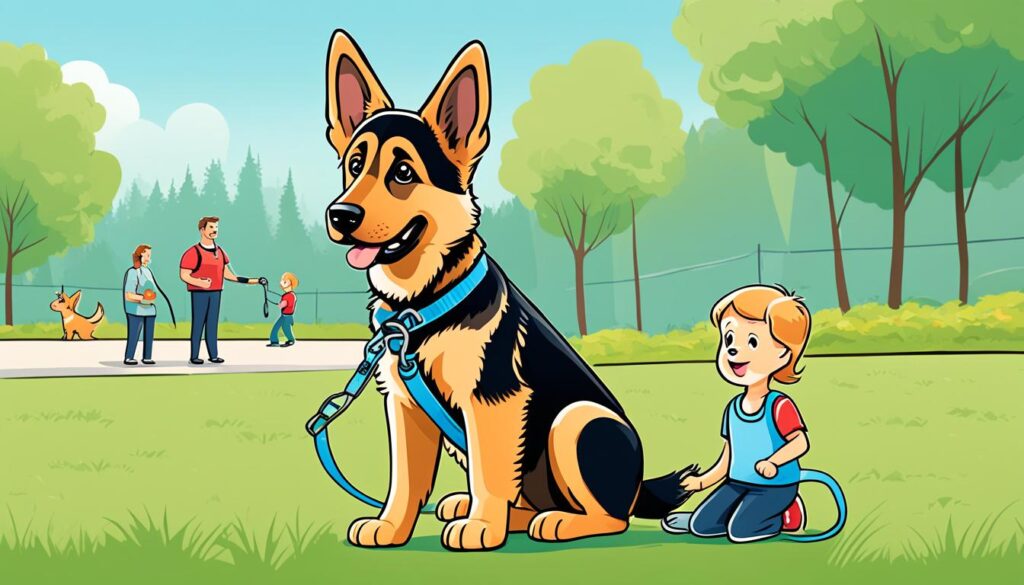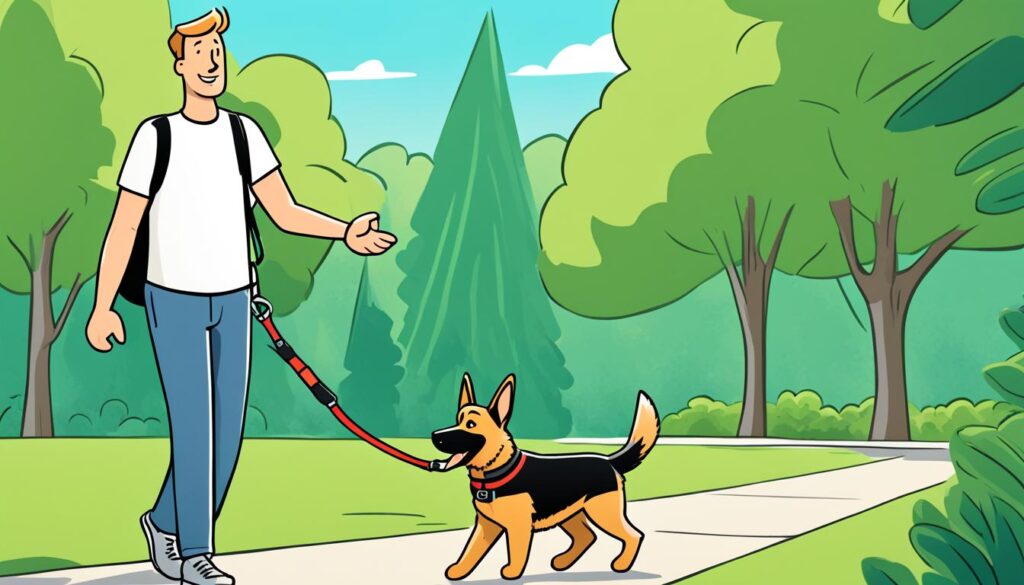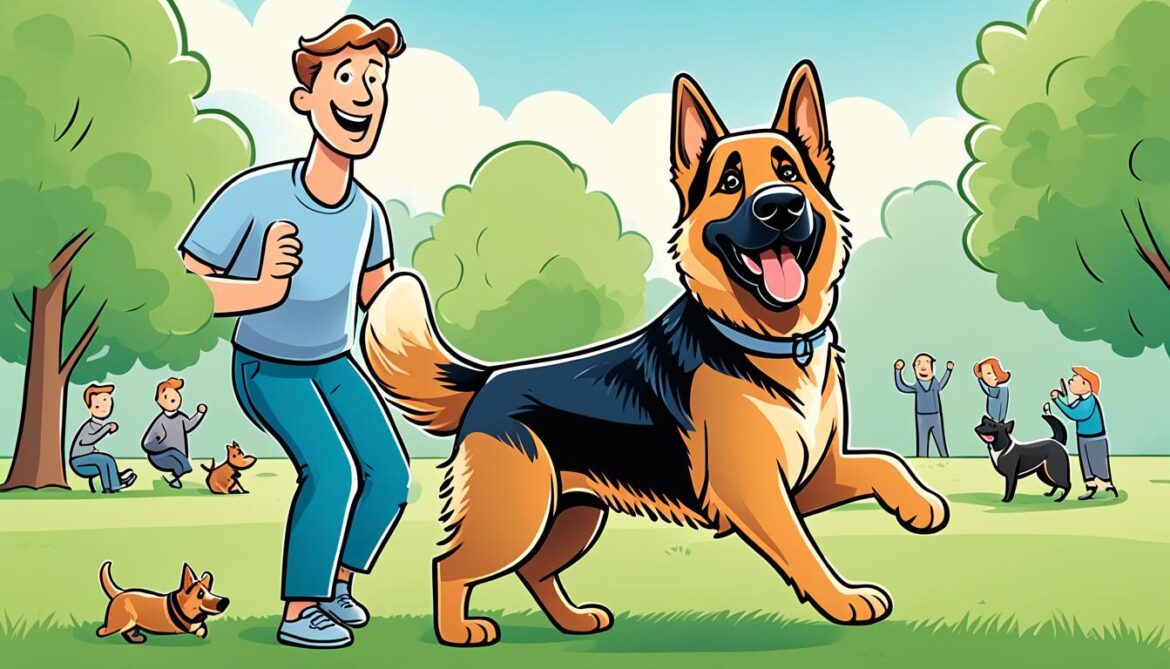Are you the proud owner of a German Shepherd? If so, you know firsthand the incredible bond that forms between you and your furry companion. The loyalty, intelligence, and boundless love they shower upon you is truly unmatched. However, as with any dog, training is key to ensuring a well-behaved and happy pup.
Whether you’re starting with a playful puppy or working with an adult dog, training a German Shepherd can sometimes be a challenging endeavor. But fear not! With the right guidance and effective techniques, you can establish a strong foundation for obedience training that will make the journey a breeze.
Key Takeaways:
- Understanding the unique nature of German Shepherds is crucial for tailoring your training methods.
- Establishing basic obedience commands sets the groundwork for a well-behaved pup.
- Utilizing crate training can aid in housebreaking and provide a safe space for your German Shepherd.
- Leash training techniques ensure your pup walks politely without pulling or becoming reactive.
- Once the basics are mastered, advanced training exercises can challenge and stimulate your German Shepherd’s mind.
Understanding Your German Shepherd’s Nature
Before diving into training techniques, it’s important to understand the nature of a German Shepherd. This will help you establish the best practices for training your loyal companion. German Shepherds are intelligent, loyal, and have natural instincts that can be harnessed through effective training methods.
“German Shepherds are known for their intelligence and ability to learn quickly. They are eager to please and thrive on mental stimulation and physical activity.”
To train a German Shepherd effectively, it’s crucial to focus on these key aspects of their nature:
1. Intelligence
German Shepherds are highly intelligent dogs and are quick learners. They have the ability to understand complex commands and tasks, making them well-suited for various roles, such as search and rescue, police work, and therapy. Their intelligence means they will excel in training when provided with clear instructions and consistent reinforcement.
2. Loyalty
German Shepherds have a strong sense of loyalty and bond closely with their owners. This loyalty makes them highly trainable and eager to please. With a strong bond and positive reinforcement, you can establish a deep trust between you and your German Shepherd, creating a solid foundation for training.
3. Natural Instincts
German Shepherds have inherent instincts that make them protective and versatile. These instincts can be utilized to their advantage during training. For example, their herding instincts can be channeled into activities such as agility training or obedience trials. Understanding and working with their natural instincts will yield the best results in training.
By understanding the intelligence, loyalty, and natural instincts of your German Shepherd, you can tailor your training techniques to suit their specific needs. The next section will delve into the best practices and effective training techniques that will help you develop a well-trained and well-rounded German Shepherd.
Establishing Basic Obedience Commands
The key to a well-behaved German Shepherd starts with teaching them basic obedience commands. By establishing a strong foundation of obedience training, you’ll build a bond of trust and communication with your furry friend. In this section, you’ll learn step-by-step instructions on how to train your German Shepherd to follow essential commands such as sit, stay, and come.
To begin training your German Shepherd puppy, follow these simple steps:
- Start with the basics: Begin training your German Shepherd puppy when they are around 8 to 10 weeks old. Keep in mind that puppies have short attention spans, so keep training sessions short and fun.
- Use positive reinforcement: German Shepherds respond well to positive reinforcement techniques. Reward your puppy with treats, praise, and affection when they successfully follow a command. This will motivate them and make training enjoyable for both of you.
- Teach the “Sit” command: Start by holding a treat close to your puppy’s nose and slowly move it upwards. This will cause their head to follow the treat, naturally guiding them into a sitting position. Once their bottom touches the floor, say “sit” and give them the treat. Repeat this several times until your puppy starts associating the word “sit” with the action.
- Master the “Stay” command: With your puppy in a sitting position, hold your hand out in front of their face and say “stay.” Take a step backward and wait for a few seconds before returning to them and rewarding them with praise and a treat. Gradually increase the distance and duration of the “stay” command as your puppy becomes more comfortable.
- Train the “Come” command: Start by getting down to your puppy’s level and saying “come” while gently pulling on their leash. When they reach you, reward them with a treat and positive reinforcement. Practice this command in different environments and gradually reduce the reliance on the leash.
Consistency is key when training your German Shepherd. Practice these basic obedience commands daily and gradually introduce more complex commands as your dog progresses. Remember to maintain a positive and patient approach throughout the training process.
Training your German Shepherd requires patience, consistency, and positive reinforcement. By investing time and effort into their obedience training, you’ll raise a well-behaved and happy companion.

| Common Basic Obedience Commands | Steps to Train |
|---|---|
| Sit | 1. Hold a treat close to your puppy’s nose and move it upwards to guide them into a sitting position. Say “sit” and reward them with the treat. 2. Repeat this until your puppy associates the word “sit” with the action. |
| Stay | 1. With your puppy in a sitting position, hold your hand out in front of their face and say “stay.” Step backward and wait a few seconds before returning to them and rewarding with praise and a treat. 2. Gradually increase the distance and duration of the “stay” command. |
| Come | 1. Get down to your puppy’s level and say “come” while gently pulling on their leash. When they reach you, reward with a treat and positive reinforcement. 2. Practice in different environments and reduce reliance on the leash gradually. |
Crate Training for German Shepherds
When it comes to training your German Shepherd, crate training can be a valuable tool for both housebreaking and providing a safe space for your furry friend. By creating a positive association with the crate, you can help your German Shepherd feel secure and comfortable.
Here are some essential steps to follow when crate training your German Shepherd:
- Selecting the Right Crate: Choose a crate that provides enough space for your German Shepherd to stand, turn around, and lie down comfortably. Consider a crate with a divider to adjust the space as your puppy grows.
- Introducing the Crate: Begin by creating a positive association with the crate. Place it in an area where your German Shepherd can see and smell it. Start by leaving the crate door open and enticing your pup inside with treats or toys.
- Encouraging Crate Time: Gradually increase the length of time your German Shepherd spends in the crate. Start with short intervals and gradually extend the time as your pup becomes more comfortable. Provide treats, toys, or puzzles to keep them engaged and entertained.
- Using a Feeding Schedule: Feed your German Shepherd their meals inside the crate. This helps create a positive association and reinforces the idea that the crate is a safe and rewarding space.
- Providing Safe Space: Ensure that the crate is a quiet and cozy area for your German Shepherd. Place a comfortable bed or blanket inside to make it inviting. Avoid using the crate as a form of punishment.
- Gradual Alone Time: Once your German Shepherd is comfortable spending time in the crate with the door closed, gradually increase the duration of alone time. Start with short intervals and gradually build up to longer periods.
Crate training requires patience and consistency. It’s essential to never force your German Shepherd into the crate or use it as a form of punishment. With time and positive reinforcement, your German Shepherd will develop a positive association with their crate, making it a useful tool for house training and providing a secure space of their own.
Expert Tip:
Always make the crate a positive and rewarding experience for your German Shepherd. Use treats, praise, and toys to create positive associations, and never use the crate as a form of punishment.
| Benefits of Crate Training for German Shepherds | Tips for Successful Crate Training |
|---|---|
| 1. Aids in housebreaking | 1. Choose the right-sized crate |
| 2. Provides a safe space for your dog | 2. Introduce the crate gradually and positively |
| 3. Helps prevent destructive behavior | 3. Use treats and toys to create positive associations |
| 4. Facilitates travel and vet visits | 4. Establish a consistent routine |
Leash Training Techniques
Leash training is an important aspect of your German Shepherd’s training journey. By teaching your dog to walk nicely on a leash, you not only ensure their safety but also enhance your bond and enjoy stress-free walks together. In this section, we will explore effective techniques for leash training that will help your German Shepherd become a well-behaved and confident walker.
Choosing the Right Leash and Collar
Before diving into leash training, it’s crucial to select the right equipment for your German Shepherd. A sturdy leash with a comfortable handle and a durable collar or harness are essential for a successful training experience. Avoid retractable leashes as they can encourage pulling and make it difficult to maintain control over your dog. Opt for a standard leash that provides you with better handling and control.
Introducing the Leash
Start by introducing the leash to your German Shepherd in a positive and gentle manner. Allow them to sniff and investigate the leash before attaching it to their collar or harness. Gradually increase their comfort level by attaching the leash for short periods while indoors or in a familiar outdoor environment. Use treats and praise to create a positive association with the leash.
Curtailing Pulling and Reactive Behavior
Pulling on the leash and reactive behavior can make walks unpleasant and unsafe. To address these issues, practice the following techniques:
- Stop and Stand Still: When your German Shepherd starts pulling, stop walking and stand still. Avoid giving any attention or tension to the leash. Wait until your dog responds by releasing tension and turning back towards you. Use verbal praise and reward them with treats for walking by your side.
- Change Directions: Randomly change your walking direction when your dog pulls. This will catch their attention and encourage them to walk by your side to maintain the connection. Reward and praise them when they follow your lead.
- Use Positive Reinforcement: Reward your German Shepherd with treats, verbal praise, and petting whenever they walk nicely on the leash without pulling. This positive reinforcement will reinforce the desired behavior and motivate your dog to repeat it.
Consistency and patience are key when leash training your German Shepherd. Remember to always remain calm and avoid punishment or jerking the leash as it can cause anxiety or injury to your dog.

Gradual Exposure to Distractions
As your German Shepherd becomes more comfortable walking on the leash, gradually expose them to different environments and distractions. Start with quiet areas and slowly introduce them to busier streets, parks, or areas with other dogs. This gradual exposure will help build their confidence and focus, ensuring they remain well-behaved even in stimulating environments.
“Leash training is about teaching your German Shepherd to walk by your side with confidence and obedience. It requires patience, consistency, and positive reinforcement.”
By following these leash training techniques, you can transform your German Shepherd into a well-behaved walking companion. Remember that every dog is unique, and the training process may vary in duration and progress. Celebrate small successes and be persistent in your efforts. With time and dedication, you and your German Shepherd will enjoy many enjoyable walks together.
Advanced Training for German Shepherds
Once your German Shepherd has mastered the basics, it’s time to take their training to the next level. Advanced training exercises will not only strengthen the bond between you and your dog but also provide mental stimulation and promote overall well-being.
Here are some key areas to focus on for advanced training:
Advanced Commands:
Expand your dog’s repertoire of commands beyond the basic obedience cues. Teach them more complex commands such as “fetch,” “roll over,” or “play dead.” These advanced commands will challenge their intelligence and keep them engaged during training sessions.
Agility Training:
Engage your German Shepherd in agility training exercises, which involve navigating through obstacles like jumps, tunnels, and weave poles. Not only does agility training enhance their physical fitness, but it also helps improve their coordination, balance, and focus.
Specialized Training:
If you have specific goals in mind for your German Shepherd, consider specialized training for roles such as search and rescue or therapy work. Professional German Shepherd training programs can help you refine your dog’s skills and provide them with the necessary training to excel in these specialized roles.
Remember, advanced training requires patience, consistency, and positive reinforcement. Break down the training exercises into manageable steps, and always reward your dog for their progress and successes.
By continuing to challenge your German Shepherd with advanced training, you can unlock their full potential and create an even stronger bond between you and your loyal companion.
Addressing Common Training Challenges
Training a German Shepherd can be a rewarding but challenging endeavor. Despite their intelligence and trainability, these loyal and spirited dogs may present certain obstacles along the way. It’s important to approach these challenges with patience, consistency, and effective training techniques. In this section, we will explore common training issues and provide tips and strategies to help you overcome them with confidence.
1. Overcoming Stubbornness
German Shepherds are known for their independent nature, which can sometimes manifest as stubbornness during training sessions. To overcome this challenge, establish clear boundaries and set expectations from the beginning. Use positive reinforcement techniques, such as treats and praise, to motivate and reward desired behaviors. Consistency is key – stick to your training plan and remain patient, and your German Shepherd will eventually understand what is expected of them.
2. Managing Aggression
Although German Shepherds are generally gentle and friendly, some dogs may exhibit signs of aggression. Proper socialization and early training are crucial in preventing aggressive behaviors. If your German Shepherd displays signs of aggression, it’s essential to seek professional help from a qualified dog trainer or behaviorist. They can provide you with the necessary guidance and techniques to safely address and manage aggression, ensuring the safety of both your dog and those around them.
3. Dealing with Separation Anxiety
German Shepherds are loyal and devoted companions, which can sometimes result in separation anxiety when they are left alone. This anxiety may lead to destructive behaviors, excessive barking, or attempts to escape. To address separation anxiety, gradually expose your dog to short periods of alone time, gradually increasing the duration as they become more comfortable. Provide them with engaging toys, a safe space, and plenty of mental and physical exercise to help alleviate anxiety. If necessary, consult with a professional dog trainer or veterinarian for additional guidance.
By understanding and addressing common training challenges, you can ensure a successful and enjoyable training experience with your German Shepherd. Remain patient, consistent, and always remember that each dog is unique, requiring customized training approaches. Now, let’s take a look at a table summarizing these common training challenges and their corresponding strategies:
| Training Challenge | Strategies |
|---|---|
| Stubbornness | Establish clear boundaries, use positive reinforcement, and stay consistent. |
| Aggression | Seek professional help, socialize your dog, and utilize appropriate training techniques. |
| Separation Anxiety | Gradually expose your dog to alone time, provide mental and physical stimulation, and consult with professionals if needed. |
Conclusion
Congratulations on taking the first step towards effective German Shepherd training! Throughout this article, we have explored various tips and techniques to help you establish a strong foundation for obedience and behavior training. By understanding the nature of your German Shepherd and implementing consistent training methods, you can ensure a well-behaved and happy companion.
Consistency is key when it comes to training a German Shepherd. Make sure to set aside regular training sessions, using positive reinforcement techniques such as praise, treats, and playtime to motivate your dog. Patience is also crucial as German Shepherds require time to understand and internalize commands.
Remember, training your German Shepherd should be a positive and enjoyable experience for both you and your furry friend. Use rewards and praise to encourage desirable behaviors and avoid punishment-based methods. With persistence and a loving approach, you can foster a strong bond and successfully train your German Shepherd to be a well-behaved and obedient companion.
